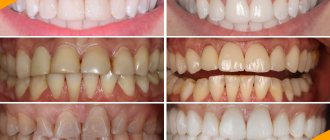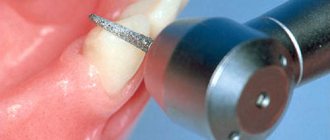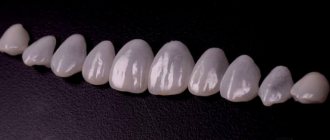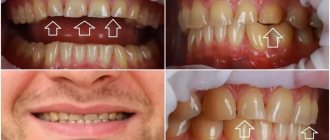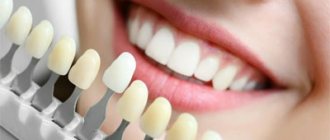Veneers are microprostheses that are widely used in aesthetic dentistry and allow you to achieve the ideal appearance of the anterior group of teeth. They are used in cases where existing defects cannot be corrected by other methods or the result is needed in a short time. Unlike crowns, they do not completely cover the teeth, but only their front part and the cutting edge. Most often, veneers are installed on the 8 lower and 10 upper teeth. Is it necessary to install veneers, their pros and cons - this is discussed in our article.
What are veneers for?
In what cases are veneers placed on teeth? Installation of veneers is recommended for:
- darkening of the enamel that does not disappear after the whitening procedure;
- cracks and chips;
- non-carious enamel damage (fluorosis, tetracycline staining);
- irregularities in shape (uneven teeth) and position of teeth.
Restorations with veneers can be direct or indirect. The first ones are carried out directly in the patient’s mouth, and indirect ones - in a laboratory setting. Indirect ones allow you to achieve higher aesthetic results; teeth after such restorations look more natural, and veneers made of zirconium, ceramics or composite materials are used for their implementation.
When are veneers used?
Let's start with the fact that veneers, thin plates made of composite materials or ceramics, are installed on the vestibular surface of the frontal (and, more recently, premolars) in order to mask multiple small defects. These include: change in enamel color; cracks; chips; interdental gaps and many other imperfections that have arisen as a result of improper oral hygiene or formed due to various dental diseases or the result of their treatment.
A pulpless tooth, that is, a tooth with a removed nerve and a canal filled with filling material, tends to change color after a certain time. A filling, if the dentist does not follow the rules for filling root canals or if low-quality material is used, can also change color, which negatively affects the appearance of the tooth. If the general satisfactory condition of the pulpless tooth and the teeth adjacent to it, an experienced dentist can make a positive decision to install a veneer on it. The choice of treatment method, type of veneer, number of teeth to be restored, as well as the material used to make cosmetic plates depends on the doctor.
If, before placing veneers on pulpless anterior teeth, the doctor considers it advisable to replace old fillings, additional treatment and intracanal tooth cleaning, the patient must strictly follow all instructions. In most cases, the specialists of our dental clinic consider such preparation measures to be mandatory, since thanks to their implementation, the installation of veneers on pulpless teeth becomes not only possible, but also guarantees an excellent result.
Does it hurt to put veneers on teeth?
Veneers are micro-prosthetic onlays, during the installation of which nerves are not removed and soft tissues are not damaged. Before installing them, a layer no more than 1.2 mm thick is removed from the tooth, and the procedure itself is preceded by anesthesia, which guarantees a complete absence of unpleasant sensations. The time required to prepare the tooth is about half an hour.
The pads do not cause discomfort when worn. After just a few days, the patient perceives the veneers as part of the teeth. The changes will only be aesthetic and for the better.
How long does it take to replace veneers?
The service life of veneers depends on many factors:
- Material. Ceramic ones are more durable;
- The patient’s lifestyle, how carefully he “handles” dental veneers;
- Doctor's professionalism. If mistakes were made during installation, for example, the materials were not dried correctly, the veneers will not last long.
There is no clear period after which the linings must be replaced. This should only be done if there is an objective need. For example, if the veneer:
- Broken off;
- Peeled off;
- Darkened (relevant for composite overlays).
Dental veneers: pros and cons
Installation of veneers is one of the most popular methods of aesthetic dentistry, preferred by many patients. We will look at the main pros and cons of dental veneers, which will help you assess the risks and draw the right conclusions.
Advantages of veneers:
- Long service life. Varies depending on the quality of materials and technologies used and can reach 10 years.
- Resistance to staining. This is typical for ceramic veneers, which are highly resistant to all coloring substances without exception. The appearance of ceramic veneers remains unchanged throughout their entire service life.
- Natural look. Microprostheses are selected in accordance with the color of the enamel of natural teeth, so they look as natural as possible.
- Quick installation. Veneers will take a maximum of one week to complete, although they usually take much less time.
- Simple procedure. Unlike crowns, much less tooth tissue is removed, so the procedure takes less time and requires less effort.
Disadvantages of veneers:
- Strength. Veneers are considered to be quite wear-resistant structures; however, when using them, you should avoid eating too hard food and be careful when practicing martial arts (boxing, wrestling, etc.).
- Need for replacement. At the end of their service life (usually about 10 years), veneers must be replaced.
- Difficult to select for teeth with dark shades. Ceramic veneers are transparent, so they cannot correct teeth that are too dark.
- Tooth preparation. To install veneers, a layer of dental tissue is removed - this is a painless procedure, which is more gentle than when installing crowns, but, nevertheless, this is what worries patients most often.
- Price. Microprostheses are quite expensive products, the price of which is higher than that of crowns. Why are veneers so expensive? The determining factors in this case are the technologies and materials used. The most expensive are ceramic veneers (Lumineers).
How to install ceramic veneers
Ceramic veneers are installed after diagnosis and complete dental sanitation. The installation is carried out in several stages:
- The doctor prepares (grinds) the teeth, takes an impression and places temporary veneers;
- Creates a 3D model of future onlays and sends it to the dental technician for work;
- Trying on finished veneers and, if there are no comments, installation.
The whole process takes from 7 to 10 days. Refractory porcelain veneers may take longer to fabricate and install.
Types of veneers
For the manufacture of veneers, two types of materials are used, based on which the following types of products are distinguished:
- Ceramic. In turn, they are divided into porcelain and zirconium. The latter uses zirconium to make the frame, but the veneers themselves are also made of porcelain. They are more reliable than conventional pressed ones, but have less transparency due to the dense frame. The material for making veneers should be selected based on the color of the enamel of natural teeth. For transparent enamel, porcelain microprostheses are more suitable.
- Composite. Veneers, the manufacture of which can even be done by a general practitioner, since the entire process is carried out directly in the patient’s mouth. Therefore, they are often compared to conventional fillings. To produce high-quality composite veneers, you will need a well-equipped laboratory.
Veneer care
Composite and ceramic dental veneers do not require any special care, but they must be treated with care, since, like tooth enamel, these materials are relatively fragile.
If the patient had the habit of biting off hard fruits and vegetables with his front teeth - carrots, apples, etc., cracking nuts, biting off thread, he will have to give it up.
Veneers cannot be bleached, but they can be professionally cleaned. You just need to warn the doctor so that he works more delicately.
If you did not find answers to your questions about veneers in this article, ask them to our specialists during a free consultation. To make an appointment, fill out the form on the website or call us.
Contraindications for installing veneers
The following contraindications exist for installing veneers:
- high tooth wear (especially in older people);
- bruxism (the habit of grinding teeth during night sleep);
- thin tooth enamel;
- presence of carious lesions;
- large chipped teeth;
- presence of large fillings;
- soft tissue lesions (gingivitis, periodontal disease, etc.);
- loss of the sixth and seventh chewing teeth.
Should I get veneers? Is there any reason to worry that their installation will harm you? The danger of veneers, which is rumored in certain circles of patients, is nothing more than a myth. We are talking about possible damage to healthy teeth when preparing them for the installation of veneers. But thanks to the advent of new ultra-thin veneers, today it is only necessary to prepare the enamel by 0.3-0.5 mm, and the tooth remains alive (crowns are installed on “dead” teeth).
What are veneers and what are they made from?
Veneers are ceramic plates installed on the outer surface of teeth in order to restore (create) the aesthetics of a smile. This restoration method refers to microprosthetics. If the teeth are miniature and there are gaps between them, then dentures can be installed without turning, only by treating the enamel to improve adhesion. In all other cases, the teeth along the front and side surfaces need a little gentle grinding. Therefore, subsequently removing the veneer and leaving the tooth “as is” will not work. You will need to either fix a new veneer or install a full-fledged prosthesis - a crown.
The thickness of the microprosthesis is 0.5 - 0.7 mm. When installed correctly, it fits tightly to the surface of the dental element and does not allow pathogenic microflora to penetrate there. Veneers are generally made from a durable ceramic alloy. It is hypoallergenic and biocompatible with body tissues. Sometimes plates are made of composite or zirconium, but ceramics, according to experts, has more reliable strength characteristics and is aesthetically identical to natural teeth.
Note: the color and shape of the veneers are selected using a special computer program using real photographs of the patient. This allows you to see the result before the actual installation of the records.
Is it worth getting veneers?
The answer of a doctor who is faced with the question of whether it is worth putting veneers on teeth is always obvious. Increased sensitivity of teeth, significant damage to the enamel, a large number of fillings on the front teeth - all this is a good reason to carry out restoration using ceramic veneers. If we are talking only about aesthetics, then the final decision must be made by the patient himself. In our opinion, this method of restoration has enough advantages and we tried to describe them as fully as possible. The only and most significant disadvantage can be considered the irreversibility of the procedure, but beauty, as we know, requires sacrifice.
Making veneers and installing them is a jewelry and creative work. Do not forget that the thickness of the microprosthesis does not exceed 0.6 mm (for lumineers - up to 0.1 mm), so your ideal smile will be guaranteed not only by advanced technologies and high-quality materials, but also by the professionalism of orthopedists and therapists. You can count on all this at Amel Dental - the only dental clinic in our country that is accredited by the Global Clinic Rating and is among the 200 best clinics in the world providing dental services.
Veneer for a pulpless tooth – yes or no?
Smooth, beautiful, healthy teeth, without defects, not affected by caries... for many today this remains only a cherished dream and, unfortunately, an unrealizable desire. The worst thing is when bad teeth are located in front, along the smile line - dark enamel, carious holes, yellowed fillings, and a tooth canal that has changed due to nerve removal greatly spoil a person’s appearance. Modern cosmetic dentistry has available means to cope with many problems of the aesthetics of the front teeth, but the question is: is it possible to install a veneer on a pulpless tooth ?
In some dental clinics, the patient will answer this question in the negative, as in the case of multiple indicators for the installation of a decorative dental plate. But you should not despair, since this does not always happen, and it is still possible to restore the front teeth that have changed as a result of depulpation using veneers.
Find out more about the benefits of veneers and lumineers
Installation Cons
Despite all the advantages, this restoration method also has some disadvantages.
- The main disadvantage is that installation requires preliminary grinding of the teeth . Accordingly, they will never have the same shape and will have to be worn constantly.
- Among the disadvantages, we can highlight some features of the materials from which they are made. For example, porcelain onlays are too fragile, and composite ones can change color.
Get professional advice on installing high-quality and attractive veneers from us. Elena Plus dentists will do everything to ensure that the veneers serve you for as long as possible.
Pulpless teeth and their preparation
Depulped teeth sooner or later undergo a number of changes. Most often, the filling or the tooth itself begins to change color (become dark or yellow), which leads to a disruption in the aesthetic appearance of not only the healed tooth, but the entire smile as a whole. This is when you should think about installing a correction plate. Often, experienced dentists strongly recommend preliminary preparation, including:
- In-canal cleaning;
- Replacing the old filling with a new one;
- If new defects are identified, they are treated.
The type of veneer, its material, the direct volume of intervention (the number of teeth on which corrective plates will subsequently be placed), as well as the amount of preliminary preparation are determined by the attending physician. These recommendations must be followed unconditionally. Only in this case can you count on a pleasing to the eye, bewitching and dazzling smile.
